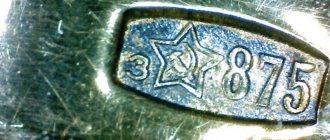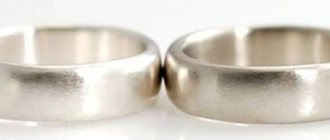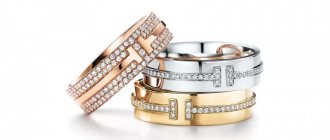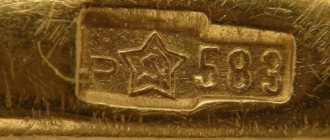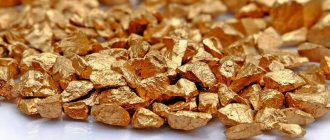Materials such as green gold are increasingly being used to make jewelry. It is an alloy of the usual yellow metal with silver, sometimes diluted with a small amount of copper and other components to obtain different shades.
Such gold is used both for the manufacture of entire jewelry and as a material for decorative inserts in them.
History of origin
The ancient peoples from the island of Crete began to use this metal for the first time. They extracted it from a natural ore called electrum. The composition of the gold alloy included from 10 to 40% silver, and there were also admixtures of copper and platinum. The material was used to make jewelry and religious paraphernalia, such as idols, temple decorations and religious objects. Electrum mining began about 3 thousand years ago.
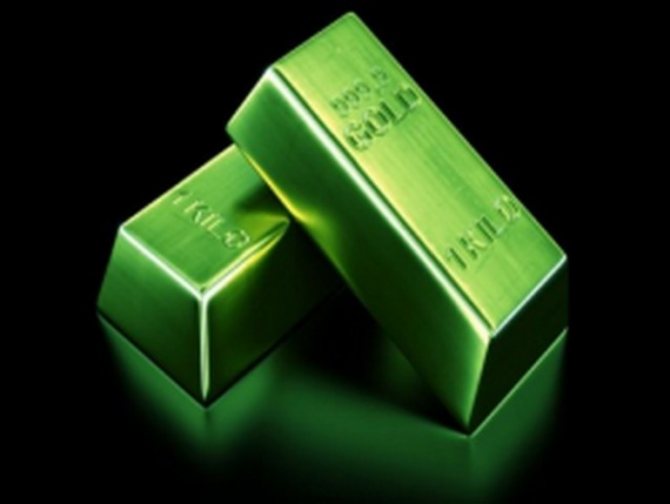
Coins made in ancient Lydia are also considered one of the oldest products made from this material. Some of them are over 2500 years old. They were used as a means of payment during the reign of King Croesus, who became famous for being the first of all rulers to impose requirements on the content of precious metals in money.
Modern jewelers recreated colored gold in the 19th century. It was already made artificially using a ligature.
In the Russian Federation and the countries of the former USSR, this alloy never gained popularity, but still found its place among connoisseurs.
From the history
Historians claim that the greenish precious metal was found in Crete. Three millennia ago, a new alloy was named electrum. Jewelers made decorative elements and all kinds of household items from it. Electrum is a naturally occurring form of gold metal in which silver and copper have been found. Coins produced during the reign of King Croesus have reached us. Antique coins have a greenish-yellow tint and the characteristic softness of gold.
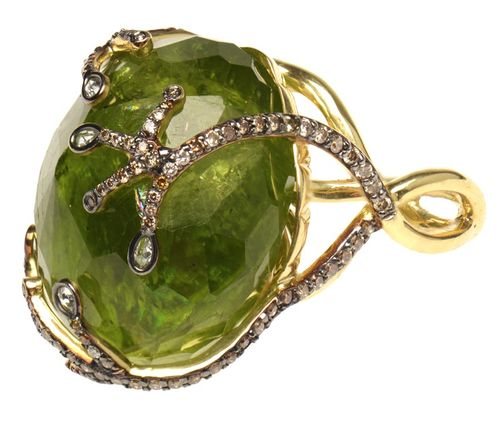
Green gold with stone
Properties and characteristics
There are certain standards that green gold must meet. In order for jewelry to be made from it, the material must meet the following requirements:
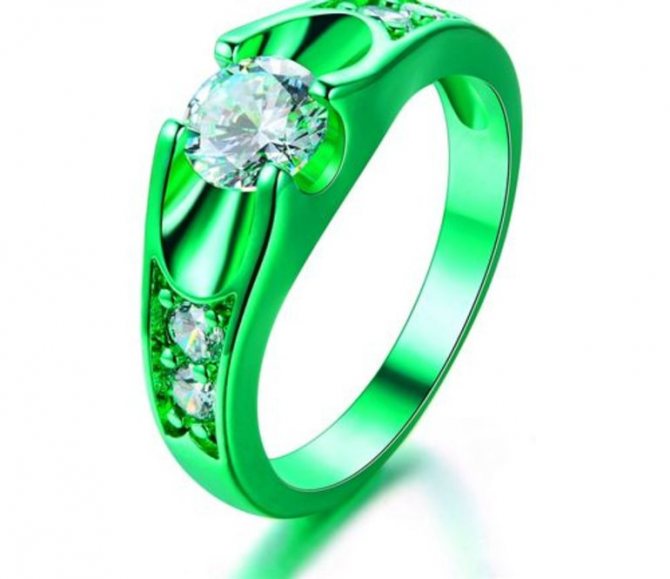
- Be inert and not enter into chemical reactions with air, water, salt, iodine, soap and other substances that a person encounters regularly. If the alloy does not meet this requirement, products made from it will be short-lived at best, and dangerous to wear at worst.
- Suitable for processing. The material for jewelry should be quite plastic, but at the same time not break when twisted, stretched or squeezed by a certain force, otherwise it will be difficult to work with.
- Be rigid and resist deformation. This is necessary to ensure that the edges of the product remain smooth and polished.
- Do not cause allergic reactions or irritate the skin. Any piece of jewelry must be suitable for long-term wear and not have a negative impact on human health.
Variants of this gold differ in color: from greenish-yellow to dark emerald.
The most saturated shades are typical for alloys with the addition of nickel, cadmium and rubidium, but they are used very rarely and only to create additional decorative elements.
What does it represent?
The only clear answer is this: it is an alloy of 750 or 585 gold with other metals that give it a greenish tint. There can be many such metals, therefore, in order to be called gold and be used in jewelry, they must meet certain requirements:
- the alloy must be inert, not oxidize in air and not react with substances, with a few exceptions;
- be flexible and also withstand certain types of stress that create internal stress, such as stretching and torsion;
- have hardness so that the edges remain polished;
- do not cause allergies.
These conditions immediately eliminate the two metals that give gold its truly green color: cadmium and rubidium. Rubidium is not suitable due to its chemical properties. For example, when it reacts with oxygen, it flares up. When alloyed with gold, it produces a metal that is too brittle to be used in jewelry. In addition, it can sometimes cause irritation upon contact with the skin.
Cadmium is not suitable due to its toxicity, therefore in Russia and the European Union it is prohibited to use it as an alloying metal. It should be noted that in some other countries it is legal to use cadmium to make jewelry. It is a silvery-white metal that causes a decrease in the melting point of metals and is often used in chemical reactions.
When inhaling vapors, a person can receive such a level of toxic substances that can even lead to death. When used in jewelry, it poses a greater danger when making jewelry than when wearing it. However, cadmium also accumulates in the body and is a carcinogen.
Sample and composition
In most countries, green gold is produced in 750 (18 karat) and 585 (14 karat) samples. Its composition may vary significantly depending on the manufacturer. Common variations of ligatures:

- 15% silver and 10% copper. A classic version of the alloy, products from which have a characteristic greenish-yellow color. It is most often used for making entire jewelry.
- 29.5% silver and 12% copper. It has a yellow color with a greenish tint.
- 25% silver. A light green alloy, most similar in its properties to natural electrum. It is used to create not only jewelry, but also souvenirs, as well as items with enamel coating.
- 38% silver and 3.5% palladium. This alloy has a light light green tint, which is given to gold by silver additives. In the Russian Federation, GOST also regulates an option with 41.5% silver, but such an alloy is already beginning to acquire a grayish color.
- 30% silver, 8% copper and 3.5% rubidium. A very beautiful metal with a rich bright green color. It is extremely fragile, difficult to process and wears out very quickly, which is why it is almost never used to create entire jewelry. It is used for making decorative inserts in rings, bracelets, earrings and pendants; it goes well with various precious metals and stones. May cause irritation in direct contact with skin. Not approved in Russia.
- 30% silver, 3.5% nickel and 8% copper. An alloy with an olive tint. It has good strength and is easy to handle, but in approximately one in eight cases it causes allergic reactions when worn for long periods of time. Like an alloy with the addition of rubidium, it is not used in the Russian Federation.
- 23% copper and 2% cadmium. Option with light green color. Since cadmium is toxic, its use as a ligature is prohibited in the Russian Federation and EU countries, but in other countries such an alloy is sometimes used to create elements that do not come into contact with the skin.
- 15% silver, 6% copper and 4% cadmium. A very nice looking metal with a rich dark green color. Banned in Russia and the EU, as it can cause allergic reactions and even chemical burns. It has a high melting point and is difficult to manufacture, since cadmium vapor is very poisonous.
- 29.25% silver, 11.25% copper and 1% zinc. Bright green alloy with a silver tint. Should not be used in enamel products as it contains zinc.
- 20.75% silver, 0.25% zinc and 3% copper. The metal is a rich dark emerald color. It is considered the alloy with the deepest green color of all 750 samples.
Different compositions of green gold differ from each other in characteristics and, therefore, in price, therefore the percentage of alloys and proportions of additives should be checked with the manufacturer. It should be taken into account that the GOST of the Russian Federation only approves compositions of 750 and 585 samples with the addition of silver and copper, therefore products with a rich green color are most likely fakes.
In other countries, there are variations of the gold alloy with hallmarks of 10, 12, 15 and 19 carats. They add zinc, nickel, potassium, palladium and other impurities that give the precious metal the necessary properties.
There is also gold leaf, which is used to cover products with the thinnest greenish-yellow film. For its production, tinting ligatures are required.
Green gold
Three alloying metals give gold alloys their green color. Silver in a certain proportion is the source of a slightly greenish, grassy tone. Potassium is added for an olive tint, and rich green is achieved with rubidium. The proportions of elements in alloys vary depending on the specified color standards.
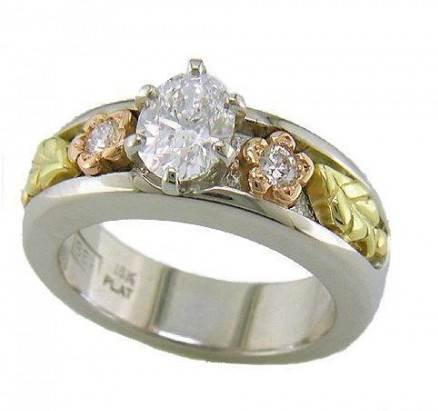
The photo shows a platinum ring in combination with red and green 585 gold
The quality characteristics of green gold leave much to be desired. The alloy is brittle, difficult to forge, and crumbles. Because of this, craftsmen rarely produce products consisting entirely of non-ferrous metal. It is used only as inserts and decorative elements.
The most viable green gold is silver-based. Solid products made from such an alloy are quite viable. However, one must skillfully maintain the proportions of metals. If there is a lack of alloying element, the mixture will remain yellow. When there is an excess of silver, white raw materials are obtained. There are two intermediate options - slightly greenish and rich yellow-green.
The most fragile version of the green gold alloy is a mixture of the yellow metal with zinc and palladium. The final product is so “hothouse” and is not able to withstand operation that it is produced only for scientific purposes, on experimental sites.
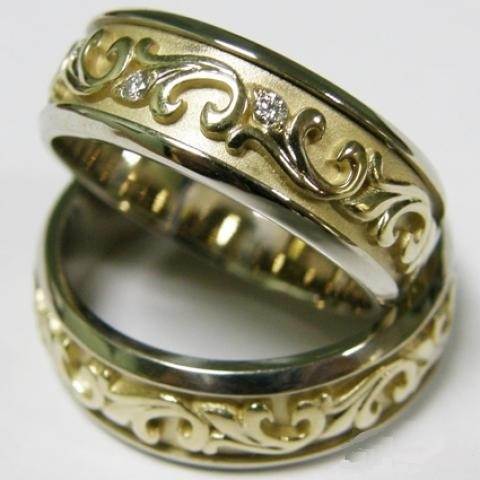
The photo shows a ring made of 585 gold alloy with a greenish tint
Cadmium also gives a greenish tone to gold. But this combination is also purely experimental. Cadmium is toxic. It is rarely used in jewelry products, in small doses.
In Russia there are 4 most common, verified formulas for obtaining green gold using a ligature:
№1 75% gold + 25% silver
This alloy formula has a subtle green tint.
№2 75% gold + 23% copper + 2% cadmium
The formula also gives a light, but clear green color.
№3 75% gold + 20% silver + 5% copper
The alloy made using this formula has a yellowish-green, rich color.
№4 75% gold + 15% silver + 7% copper + 3% cadmium
This gold has a deep, grassy, even emerald color.
The latest development is giving gold a green color without adding impurities. The method was developed by scientists from England. They focused on optical research. The surface of precious bars is given relief. Depending on the number, area, nature of the depressions and convexities, the reflective parameters of gold change. The eye begins to see metal as blue, pink, red and, of course, green.
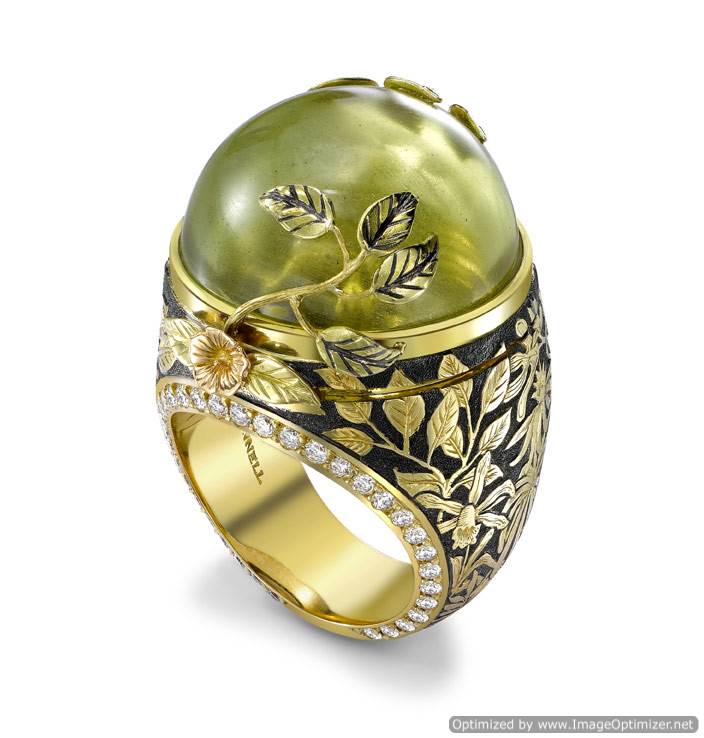
The photo shows a ring made of 585 greenish gold with diamonds and peridot
The technology has been proven, but is applicable only to ingots and other large forms. Jewelry is often too small to be treated in this way. In addition, the ribbing of products often contradicts the jeweler’s design idea. Another problem is technology. To obtain a specific shade requires expensive equipment. It is impossible to observe all the nuances of the desired relief manually.
But on gold bars there is room for your imagination to run wild. If desired, they can be made not monochromatic, but rainbow, with colorful stripes or other geometric patterns of different colors. The same can be done with sculptural compositions and decorative items. They are rarely made of gold, but the technology is also suitable for processing other metals, such as bronze or aluminum.
In America there is a brand specializing in the production of jewelry made of colored, including green, gold. The brand name is “Blask Hills”. The company's jewelers work with alloys whose gold content is below average. 10 and 12 carat alloys are used. For example, the most popular jewelry in Russia is 585-carat gold, which is equivalent to 14 carats according to the Western classification system. That is, products from Blask Hills usually contain less than half gold. This sacrifice is in favor of color. The company's technologists believe that it is with a small content of yellow metal that the colors become the most saturated and beautiful.

The photo shows a gold chain with a pendant made of 585 green gold
The examples of Russian green gold formulas given above argue with the arguments of US jewelers. However, in America, when producing a green alloy, they do not focus on silver. Overseas, potassium is used as the main alloying metal, creating completely different formulas.
In America, for example, the share of sales of non-ferrous gold products is about 30%. In Russia, in 90% of cases, reddish or yellow options are chosen. 9% of the population purchase white metal. Only 1% of citizens are buyers of colored gold. These include those who purchase a green alloy and those who prefer other colorful options.
The reason for such low activity of the population towards new products is stereotypes. People have the idea that true gold is yellow. The reason for this is millennia-old traditions. The museums display decorations and tools of the Scythians, Egyptians, and Romans. All these peoples worked only with metal of sunny tones. The ancients simply did not know the technologies for producing gold alloys of other colors. Colored gold is an innovation. Not everyone knows about new technologies. Gold is an element of prestige. Citizens want everyone to see that they are wearing gold. Few people like comments that they have wonderful silver jewelry. This is often said about white gold. Colored ones are often mistaken for costume jewelry.
The high cost of green gold is also a deterrent. The alloy is brittle and difficult to forge. Jewelers produce colorful designs with great difficulty, time and financial costs. Naturally, they ask for more for them than for standard ones, made of malleable and easy-to-process alloys. Green gold, for now, is a “sprout” on the world market. Experts predict that it will grow into a large and powerful “tree” in at least 7-10 years.
Use of metal
Jewelers use this material to make a wide variety of jewelry: rings, bracelets, pendants, earrings, brooches, clips, hair accessories, cufflinks, necklaces and chains.
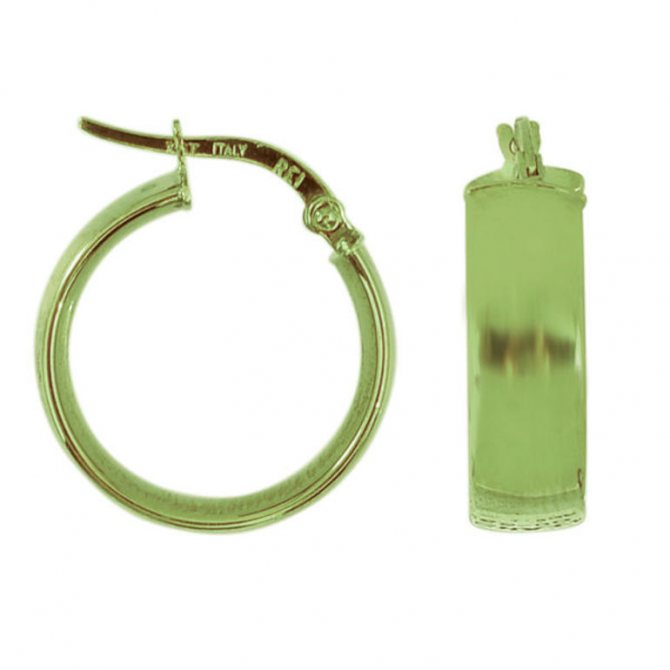
18k green gold is also used as the basis for souvenirs, awards, orders, corporate badges and enamel products. Unlike many other types of colored gold, it can be used as a base for jewelry. Jewelry made from this unusual alloy looks very exotic and seems to glow with a soft greenish light.
Unfortunately, only dull versions of electrum can be used to create an entire ring or bracelet. Mixtures with a deep green tint are usually too brittle or toxic to be useful. Nevertheless, inserts, overlays and individual elements of jewelry are sometimes made from them.
The combination of several types of green gold with each other, as well as their combination with other alloys and intermetallic compounds of different shades, looks very beautiful. The contrast between the two metals makes the jewelry unusual, and the harmonious combination of colors gives it tenderness. At the same time, a product made of such gold will almost never look too bright or vulgar, unlike classic yellow jewelry, which is quite easy to “overload”.
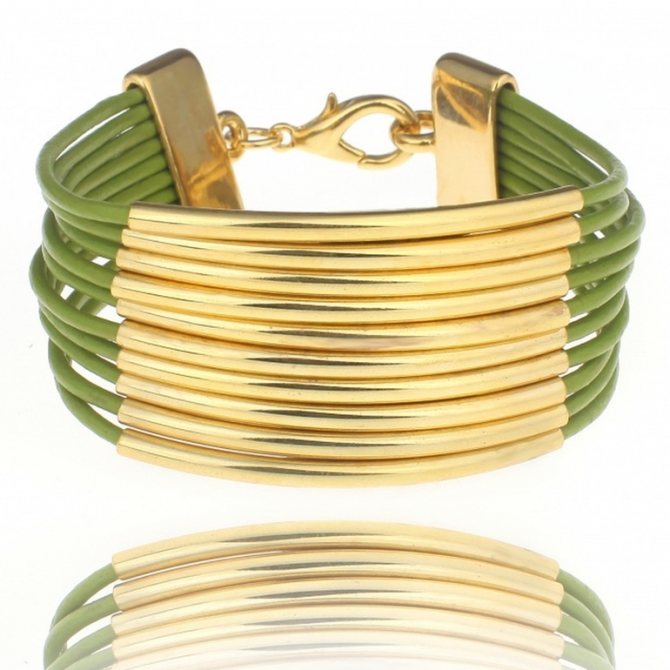
The noble green metal also goes well with many precious, semi-precious and decorative stones: from emeralds and sapphires to quartz and crystal. They can be used either as small inserts or as the main element, the beauty of which will be emphasized by a more modest-looking metal.
Plant and floral motifs are very popular in electrum products. Often in jewelry you can see inserts in the form of leaves, stems, tree crowns, vines, twigs, grapes, and so on. But there are also more austere works without any additional decorations.
Green gold is a rather rare and unusual material , which is why mass production of jewelry made from it is rare. Most of the jewelry is unique handicrafts by various craftsmen, which adds even more value and exoticism to it. However, an inexperienced person can easily mistake them for jewelry, which is the main reason for the low popularity of the alloy.
Jewelry requirements
Processing green gold requires high-level craftsmanship, patient work, knowledge and experience from the jeweler. That is why jewelers have certain requirements for this capricious alloy.
First of all, the metal must be passive to chemical reactions with air and other substances that are easily accessible to the average person in everyday life. For example, gold in combination with rubidium or cadmium has a negative impact on human health and can even leave a chemical burn on the skin.
Green metal must have sufficient ductility and resistance to mechanical stress. Otherwise, the jewelry will turn out to be very short-lived. The alloy must also have sufficient hardness to successfully undergo jewelry processing.
Very rarely, jewelers can use nickel as a ligature to obtain a precious green alloy. This metal simultaneously gives gold the strength needed for processing and a grassy tone. But when wearing such jewelry every day, there is a small percentage of the likelihood of allergic reactions.
Gold price
The price of this material is approximately the same as the cost of other alloys of 750 and 585 gold. According to the exchange rate of the National Bank of Russia, it is about 2.5-3 thousand rubles per gram and varies depending on the composition of impurities and the general situation on the market. In jewelry, the price of green gold will be slightly higher than yellow, white or red, since it is less common and more difficult to work with.
As part of rings, chains, pendants and bracelets, the cost of the alloy ranges from 6-7 thousand rubles per gram and more. But it is worth remembering that the price of jewelry depends not only on the weight of the metal, but also on the complexity of the work and the required qualifications of the jeweler. Gemstones or inclusions of other materials, such as platinum, can also add value.
In Moscow and Russia, it is quite difficult to find products made of green gold: the material is not very popular among the population and it is not possible to sell it profitably.
Differences from fakes
In the Russian Federation, under the guise of noble metal, they very often try to sell fakes at an inflated price. This is due to the fact that the average consumer is poorly familiar with the qualities and properties of this type of colored gold, and therefore is not able to recognize deception. Statistics say that approximately 4 out of 10 products are fakes, so you need to buy green gold with extreme caution. To distinguish real material from a fake, you should pay attention to the following details:

- Color. Jewelry that is dominated by rich and bright shades of green is either fake or made from alloys with toxic impurities, so you shouldn’t buy them. Classic electrum has a light yellow-greenish tint, the saturation of which depends on the content of silver and copper.
- Marking. The product must have a stamp mark indicating 585 or 750. If it is not there, then the data on the material used has not been verified or confirmed by anyone.
- Impact resistance. Fake gold tarnishes very quickly when exposed to alcohol, iodine or even salt water, while real gold does not interact with these substances in any way.
- Reaction to a magnet. The alloy should not contain impurities of iron, steel and other similar materials, therefore even a slight attraction to a magnet indicates that it is a fake.
- Condition of moving parts. For items made from fake gold, they wear out very quickly and lose color, so before purchasing, you should definitely look at all their clasps, clasps, hanging parts and links.
- Weight. Usually fake products are lighter than genuine ones. However, it will be difficult for an ordinary buyer without a jewelry scale to notice the difference unless we are talking about a whole bar or a very large piece of jewelry.
It is best to buy green gold from trusted manufacturers who enjoy the trust of customers. After purchasing, it is advisable to submit the metal for examination to find out the exact composition of the alloy. Only experienced jewelers who are already familiar with its properties and qualities should be trusted to make jewelry from this expensive material.





